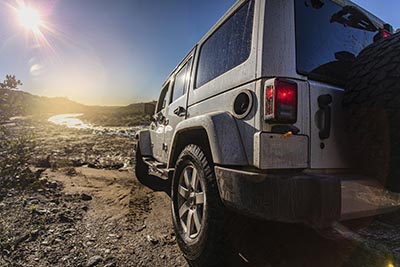
When cold weather hits and snow is in the forecast, it might be time for you to sort your Jeep out for the winter weather. Here are 5 steps you should take to keep your Jeep on the road during the Winter.
1. Check your windshield
One of the Jeep Wrangler’s defining characteristics is its upright windshield. This novel design also means that it is prone to rock chips and cracks both on, and especially off road.. Before winter, you will want to address any large cracks and get the windshield replaced. Quick temperature changes, like blasting the defroster, can turn a small chip into a sprawling crack if not addressed. These tiny cracks can usually be remedied with DIY at-home kits, which will save you a headache during Winter.
2. Test your battery
Unless getting stranded is your thing, you may want to test out your battery before the Winter. Your battery creates a chemical reaction (when the terminals are connected) that generates electrons to power your Jeep. During the lower temperatures of Winter, the battery slows this chemical reaction, resulting in less power output. Colder temperatures makes your Jeep’s engine oil thicker which, in turn, puts more resistance on your starter and battery during cold cranking.
Head to your nearest auto shop for a complimentary battery test, and replace if your battery already looks grim.
3. Check your hoses, belts and boots
What does temperature have to do with your hoses, belts and boots? Lower temperatures cause rubber components on your engine to become more brittle. This means any component that is already worn may finally give out during the cold weather.
First, check your belts while the engine is off. Inspect belts thoroughly for any signs of wear that may lead to a belt cracking or snapping. Pay special attention to areas near pulleys, since they experience maximum tension. If you see any tears or cracks, we recommend you replace the belt.
Next, check your hoses and boots. Hoses and boots in good condition should be able to be easily squeezed and should return to its original shape when released. Also check for any seepage or leaks while you inspect the ends of the hoses. If you have any doubts about your hoses and lines, they’re a relatively cheap replacement that will save you from being literally left out in the cold.
It can also be a great opportunity to upgrade your hoses to silicone hoses. There are plenty of direct-fit silicone hose kits available for Jeeps. We recommend finding a hose kit design that features a multi-layer silicone construction, complete with embedded heat-resistant fibers, which provides maximum protection against all elements.
4. Test your coolant
Your cooling system, believe it or not, is also prone to freezing in certain conditions, which can lead to permanent damage. Your Jeep engine is engineered with numerous freeze plugs that are designed to rupture if the internal fluid freezes over. When a plug ruptures, your coolant system will leak, and if a plug doesn’t function correctly, the freezing water will cause damage to your engine.
How can you prevent that? Check your cooling system to make sure it has a correct mixture of antifreeze and water. Proper mixture should be a 50/50 mix of coolant and water. NEVER MIX DIFFERENT COOLANTS. Mixing coolants can cause them to react with each other, creating a jelly-like substance which will not properly cool the engine, and lead to overheating. If you haven’t flushed your coolant in a while, now would be a good time to do so. Sediments and particulates accumulate over years of use which plug up coolant passages and reduce cooling performance. If you’re looking to put the best of the best in your car, check out Liquid Chill® Synthetic Engine Coolant/Antifreeze. Liquid Chill® is formulated to operate flawlessly under extreme conditions, whether hot or cold.
Once you full get your Jeep ready for Winter you know that Spring and Summer will be right around the corner. To get ahead for next season we recommend taking a look into a radiator for your Jeep, which is how you can help keep your engine cool during warmer months.
5. Check your heating system
Let’s be honest – you didn’t buy your Jeep because of it’s great insulation. Jeeps are known for their ability to go topless, not to mention the simple job of removing most body panels. This, however, means that your Wrangler has less than ideal winter insulation. To make up for it, Jeep heating systems are built with an integrated HVAC heating system that can heat up your cabin quickly. Checking your heating system to ensure it blows hot before Winter will prevent you from frustratingly cold drives. If your Jeep spews out cold or lukewarm air, your heater core may be clogged and will need to be unclogged for hot air to return.
Story by Eric Zuo










